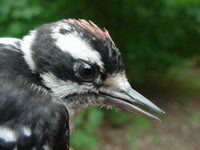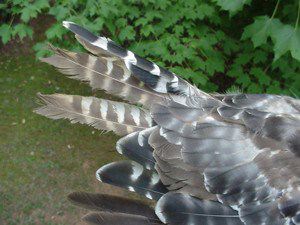|
|
|||
|
THIS WEEK at HILTON POND Installment #---Visitor # (Back to Preceding Week; on to Next Week) |
 Photos © Hilton Pond Center
|
 Eastern Phoebe (Medium-sized flycatcher with no eyering; lower mandible black; nest of green moss) |
 Downy Woodpecker (fledgling) (Young males AND females may have red on TOP of head; adult males have red on nape) |
|
Plus the following species not pictured Eastern Phoebe
|
NOTE: An apparent adult female Yellow-rumped (Myrtle) Warbler, Dendroica coronata, was observed twice on 19 June in a bird bath at Hilton Pond Center for Piedmont Natural History. The bird was seen from a distance of 20 feet with naked eye and through 10x binoculars at about 7 pm EDT. The two observations totalled three minutes and occurred in good light with unobstructed view. Observers included Bill Hilton Jr. and Susan Hilton. The bird was seen momentarily in the bird bath again on 21 June at 5:30 pm. The yellow crown, flanks, and rump patch were clearly visible as the bird fanned its feathers in the water. A dark (but not black) mask surrounded each eye, and the dorsal plumage appeared gray-black; these plumage characters indicated that the bird was probably a female. Wing bars were white but not pronounced. Prominent white spots on the outer tail feathers indicated the bird was likely at least a year old. There are almost no substantiated summer records for this species in South Carolina; in fact, yellow-rumps may be considered "accidental" at this time of year. Only one record (16 July 1940, Berkeley County, with no details) is included in Status and Distribution of South Carolina Birds (Post and Gauthreaux 1989). Typical breeding range for the species is Canada and the northern tier of the U.S. |

 This week's Red-shouldered Hawk (above) was pretty scruffy; it was in heavy molt, with last year's dull and tattered wing and tail feathers being replaced sequentially by smooth and shiny new ones (right). The bird was small--indicating it probably was a male--and the overall plumage characteristics and muddy brown eye color showed it was a second-year bird hatched in 1999. Unlike our breeding Broad-winged Hawks that overwinter in South America, it's likely that some Hilton Pond red-shouldereds are year-round residents, while others that are non-breeders may float in and out of the area during summer. Local populations of this species appear to increase in winter as birds from further north migrate in to take advantage of milder temperatures in the Carolina Piedmont.
This week's Red-shouldered Hawk (above) was pretty scruffy; it was in heavy molt, with last year's dull and tattered wing and tail feathers being replaced sequentially by smooth and shiny new ones (right). The bird was small--indicating it probably was a male--and the overall plumage characteristics and muddy brown eye color showed it was a second-year bird hatched in 1999. Unlike our breeding Broad-winged Hawks that overwinter in South America, it's likely that some Hilton Pond red-shouldereds are year-round residents, while others that are non-breeders may float in and out of the area during summer. Local populations of this species appear to increase in winter as birds from further north migrate in to take advantage of milder temperatures in the Carolina Piedmont. It's always tricky to take a hawk out of a mist net; they're usually on their backs with legs and talons extended toward the approaching bander, and the bander must beware. The Red-shouldered Hawk in these photos was fairly docile and--like most buteos--never attempted to use its sharply hooked beak as a weapon; however, the bander never let go of those powerful legs, lest the talons provide a permanent memento of the day's hawk-banding encounter. Hawk the size of red-shouldereds require special lock-on bands; these include two flanges that fold together to keep the hawks from prying the bands open with their powerful beaks.
It's always tricky to take a hawk out of a mist net; they're usually on their backs with legs and talons extended toward the approaching bander, and the bander must beware. The Red-shouldered Hawk in these photos was fairly docile and--like most buteos--never attempted to use its sharply hooked beak as a weapon; however, the bander never let go of those powerful legs, lest the talons provide a permanent memento of the day's hawk-banding encounter. Hawk the size of red-shouldereds require special lock-on bands; these include two flanges that fold together to keep the hawks from prying the bands open with their powerful beaks.